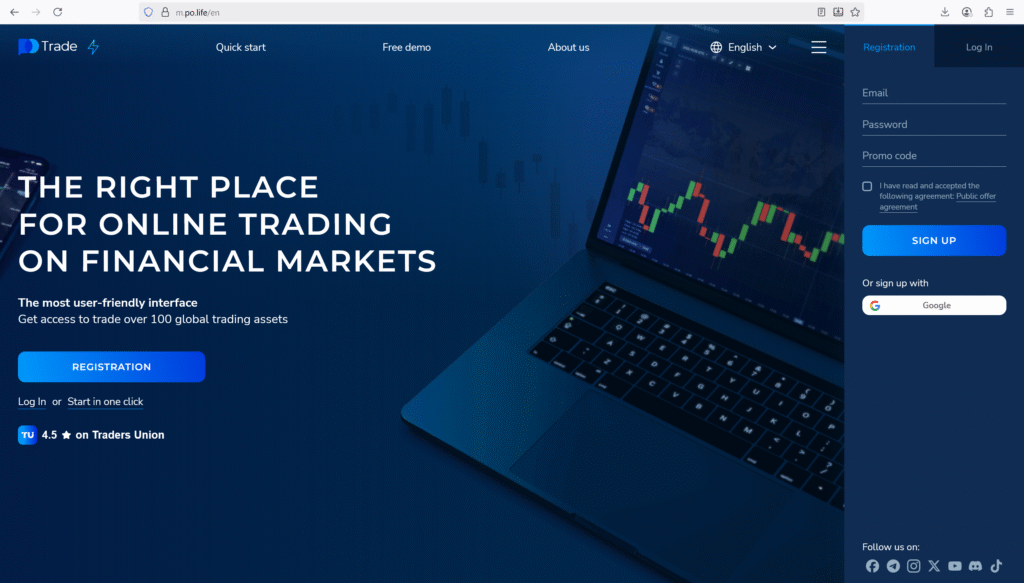PO Trade (m.po.life) markets itself as “the most innovative trading platform,” offering zero commissions, instant deposits and withdrawals, social trading, copy trading, and 100+ assets. But beneath that glossy interface lies a host of structural red flags, inconsistencies, and patterns common to high-risk / potentially fraudulent platforms. In this exposé, we reveal seven startling warnings that suggest PO Trade may be more illusion than investment opportunity.

1. The Upgrade Narrative: Promising More Than Reality Allows
At its core, PO Trade crafts an “upgrade promise” geared to appeal to both new and seasoned traders. It touts instant withdrawals, zero deposit commissions, flexible instruments, social trading features, and high payouts (claims like up to 218%). Those are seductive promises of enhancement—better returns with fewer barriers. But whenever a platform claims upgrades that defy industry norms, one must ask: what’s the catch? The gap between marketing language and operational truth is almost always where risks lie. The “upgrade narrative” is meant to reduce friction in onboarding—you see the promise first, and worry about verification later.
2. Ownership, Registration, & Regulatory Ambiguity
The site claims that “PO Trade Ltd” is registered in St. Lucia (Rodney Bayside Building, Gros-Islet) with registration number 2019-00207. That provided address and entity is used to lend some legitimacy. But a local offshore registration is not equivalent to robust financial regulation. The site also states it does not serve residents of multiple jurisdictions (EEA, USA, UAE, Israel, Brazil). That exclusion is often used by speculative platforms to avoid stronger regulators. Meanwhile, no convincingly verifiable license (e.g. from a major regulator such as FCA, CySEC, ASIC) is prominently displayed or validated via official registers. Registration in a low-oversight jurisdiction + jurisdiction exclusions + absence of transparent licensing raises serious doubt about real regulatory protections.
3. Domain & Trust Signals Raise Caution
Domain analysis and independent trust ratings show troubling signals. PO Trade employs domain privacy and does not openly reveal full ownership. Its trust score in review engines is moderate to low, partly because it is relatively new and because of shared server infrastructure with other risky domains. The site’s claims of “100+ trading instruments, flash deposits & withdrawals, promos & bonuses, social trading” mirror many platforms that have been flagged as high-risk. The mix of high promises + anonymity + technical overlap with suspicious domains is a red flag cluster.
4. User Reviews: Glowing Praise with No Proof
PO Trade displays multiple 5-star reviews on its own platform interface, praising ease, features, and withdrawals. But those reviews lack independently verifiable proof—no screenshots of withdrawals, no bank statements, no third-party confirmations. On review aggregators outside its control, there is much less visibility; complaints are sparse or suppressed. When a site’s self-published reviews are overwhelmingly positive but independent evidence is minimal, it suggests testimonial manipulation or influence, rather than genuine user experience.
5. Withdrawal & Deposit Promises vs. Real Exit Barriers
PO Trade claims “instant deposits and withdrawals” with “no commission.” Yet many platforms structured this way include hidden withdrawal constraints—such as minimum withdrawal thresholds, mandatory trading volume, “verification fees,” or “processing hold periods.” Because PO Trade excludes certain jurisdictions and disclaims service to the USA, EEA, etc., it may assume fewer oversight challenges. If users try to withdraw larger sums, the platform can impose KYC, AML checks, conversion into tokens, or other compliance barriers. The claim of instant withdrawal is likely conditional or limited—an upgrade façade rather than guaranteed service.
6. Mixed Asset Claims & HYIP-Style Features
PO Trade promises a wide suite: binary options, forex, commodities, stocks, signals, social trading. That breadth is attractive—but when unaccompanied by transparent infrastructure, it becomes a hallmark of HYIP / Ponzi models. Many hybrid platforms over-promise across multiple asset classes to capture more types of depositors, even without the underlying infrastructure to support fully credible trading across all those markets. Combined with promotional features like bonuses, tournaments, or high payout percentages (e.g. 218%), it further suggests risk of unsustainable liability. When so many promises stack up together, the model must be questioned.
7. The Timing Trap & Psychological Pressure
Finally, in many reports, platforms like PO Trade use timing pressure and emotional nudges. They advertise limited-time bonuses, contests, promo codes, “special offers,” or “fastest payout windows” that expire quickly, pushing users to deposit more before verifying. That sense of urgency short-circuits due diligence. Once users commit, the internal system and support may become less responsive, and exit hurdles may appear only after capital is tied up. The “upgrade offer” shifts from open opportunity into a psychological trap.
Conclusion: The Illusion of PO Trade’s “Most Innovative Platform” (500 words)
PO Trade presents itself as the cutting edge of online trading: sleek design, social and copy trading, broad asset classes, and claims of “instant withdrawals.” But every modern scam has adopted a similar playbook. The shine is often superficial; when you scratch beneath it, structural weaknesses emerge.
First, registration in a low-regulation jurisdiction—even with a local address—does not substitute for real oversight. The platform’s exclusion of major jurisdictions suggests a defensive posture: avoid the scrutiny that comes with operating in regulated markets. True legitimacy comes from willingly submitting to regulation, not hiding behind exemption.
Second, the upgrade narrative—more assets, faster withdrawals, bigger returns—is seductive, and that is precisely why these platforms use it. It entices eager users to deposit before they pause to verify. But real financial platforms don’t promise instant wealth; they disclose risk, volatility, and the potential for loss. The absence of those disclosures speaks volumes.
Third, self-published reviews claiming stellar experiences must be viewed with skepticism unless backed by third-party evidence. The positive stories on PO Trade’s site may simply be part of the marketing machine. A credible platform would allow objective review, transparent withdrawal proofs, and open user reporting. Where independent complaints are missing or hard to find, suspicion deepens.
Fourth, withdrawal promises are often conditional—even when stated as “instant.” In practice, many users in skeptical platforms eventually face KYC walls, minimums, delayed processing, or account freezing. Such barriers are usually invisible until after large deposits are made. The upgrade becomes the illusion when the implied freedom to exit disappears.
Fifth, the breadth of asset promises—binary, forex, crypto, commodities, social features—opens many vectors for failure. Many platforms promising all of that simply cannot maintain true liquidity, execution, or legitimacy across all those markets. That strain contributes to inconsistency and eventual collapse.
Sixth, the timing and bonus pressure tactics convert curiosity into haste. Promotions that expire quickly, countdown timers, or “join now” banners prime users to act before thinking. Once accounts are active, extra obstacles or complacency in customer support often follow. That shift is deliberate—psychological capture over technical transactions.
For anyone considering PO Trade, don’t accept the facade. Demand: verifiable license evidence (not just claims), public audit reports, detailed withdrawal logs from ordinary users, and independent regulatory validation. If any of those are missing or delayed, treat the platform as high risk.
If you or someone you know has funds in PO Trade, act quickly. Attempt a small withdrawal first and track the response. Preserve all evidence—screenshots, messages, transaction details. Report the platform to your financial regulators, consumer protection agencies, and, if assets are in crypto, to blockchain trace services. The sooner complaints mount, the harder it is for the platform to hide or rebrand.
PO Trade’s image is modern and promising. But at its heart, it is built on claims—not transparency. The “upgrade” it promises is in your expectations, not your results. In finance, the ultimate measure is not what a platform can show—it is what it lets you take out. When withdrawal is no longer assured, the upgrade has become an illusion.


